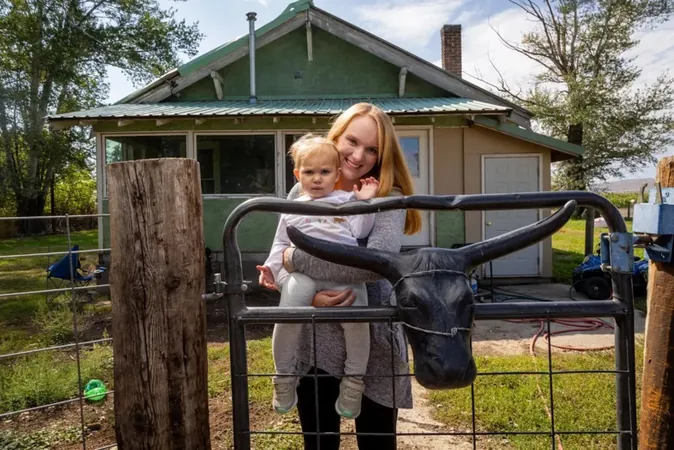
The Shocking Closure of Oregon's Maternity Ward: A Warning Sign for Rural Families
2025-09-22
Author: Kai
In the early hours of April 2, 2024, Teela Banister found herself in a terrifying race against time. Expecting her second child and living on the outskirts of Baker City, Oregon, her only option for emergency care involved an hour-long drive since the local Saint Alphonsus Medical Center had shut down its labor and delivery unit just months before.
"The thought of potentially giving birth on the highway was terrifying," she recalled. Given her quick first delivery, the stakes felt even higher.
As the couple navigated the treacherous route, disaster struck. Just 20 minutes into their journey to La Grande, her water broke. By the time they arrived at the hospital, Teela was cradling her newborn—a little girl who was in distress due to fluid in her lungs. Thanks to her quick instincts, she was able to help her baby breathe until medical professionals could take over.
Teela's story is far from an isolated incident. Since the Baker City maternity ward closed, many families are left grappling with the loss of reliable obstetric care, with dire consequences looming.
Medicaid Cuts Threaten Rural Maternity Care
These alarming situations highlight a broader crisis. The imminent cuts to Medicaid, as a result of President Trump's recent legislation, threaten to exacerbate the already fragile state of rural healthcare. With the Oregon Health Plan set to lose over $11 billion in funding through 2031, the outlook is grim for many families relying on Medicaid for coverage.
About half of all births in Oregon are funded by Medicaid, making hospitals increasingly vulnerable. The chairman of Grande Ronde Hospital, Jeremy Davis, noted that many hospitals—especially smaller ones—operate on painfully thin margins, depending heavily on these government programs.
Rural Hospitals Struggling to Survive
The repercussions of hospital closures due to financial strain are all too real. As operating costs rise and patient numbers dwindle, smaller hospitals are left with difficult decisions. Providence Seaside Hospital and the Oregon Medical Group are already scaling back maternity care services, with more closures anticipated if funding cuts proceed.
A striking trend shows that more than 500 hospitals in the U.S. have shut their obstetrics units since 2010, leaving a significant segment of rural and urban areas without essential services.
Community Concerns and Personal Struggles
Locals like Shelley Payton, a doula in Baker City, have begun filling the void left by these closures. As road conditions worsen in winter months and anxieties grow, expectant mothers face an uphill battle to access care. Payton has received countless messages from women worried about how to reach La Grande in case of complications, revealing the pervasive fear and uncertainty gripping the community.
Some women have even opted to temporarily relocate closer to a hospital before their due dates, fearing they won't make it in time. One mother, Dallas Pfeiffer, faced this dilemma after the maternity ward closed and was advised by her doctor to seek care in a larger facility nearby.
The Impacts on Health Outcomes
Experts warn that shutting down maternity units leads to dangerous outcomes, with studies showing increased risk for premature births and higher maternal and infant mortality rates. The distance to hospitals can exacerbate these risks, pushing expectant mothers towards unplanned home births or ER deliveries.
As we see more rural hospitals falter under financial stress and looming Medicaid cuts, families across Oregon face an increasingly uncertain future. Without immediate intervention and restructuring, the ramifications could be catastrophic for rural maternity care.
Will we witness more birth centers closing their doors? Teela Banister’s story serves as a chilling reminder that for many in rural areas, safe and accessible childbirth is becoming a fading reality.



 Brasil (PT)
Brasil (PT)
 Canada (EN)
Canada (EN)
 Chile (ES)
Chile (ES)
 Česko (CS)
Česko (CS)
 대한민국 (KO)
대한민국 (KO)
 España (ES)
España (ES)
 France (FR)
France (FR)
 Hong Kong (EN)
Hong Kong (EN)
 Italia (IT)
Italia (IT)
 日本 (JA)
日本 (JA)
 Magyarország (HU)
Magyarország (HU)
 Norge (NO)
Norge (NO)
 Polska (PL)
Polska (PL)
 Schweiz (DE)
Schweiz (DE)
 Singapore (EN)
Singapore (EN)
 Sverige (SV)
Sverige (SV)
 Suomi (FI)
Suomi (FI)
 Türkiye (TR)
Türkiye (TR)
 الإمارات العربية المتحدة (AR)
الإمارات العربية المتحدة (AR)